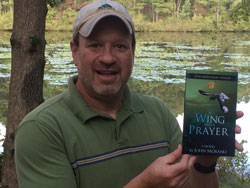In celebration of the 25th anniversary of his novel, A Wing and a Prayer, John Morano, a professor of journalism, released the sixth edition on Monday, Oct. 3. As the first book of the Eco-Adventure Series, new illustrations by Sarah Anderson and an Introduction by Mark Tercek, President and CEO of The Nature Conservancy, are now featured.
“I was dying to fix [A Wing and a Prayer] up, dying to put a new coat of paint on it… It now reads the way I have always wanted it to read,” commented Morano.
Published by Grey Gecko Press, an eco-friendly publishing house, the novel follows Lupe, the last living Guadalupe Petrel, as he battles human captivity and desperately yearns for a mate to save his species.
Jason Aydelotte, the “Chief Gecko” of Grey Gecko Press, stands strongly behind Morano’s work. “One of the most powerful messages in Morano’s books is the idea of ecological stewardship – of being a responsible member of not only the human race, but the dominant race on the planet. It’s on our shoulders as humans to work harder to maintain a balance with the world’s ecosystems, and one that we at Grey Gecko take quite seriously. He shows us a world that we affect, in many ways harmfully, yet still manages to give us hope that we can be… well, better,” said the publisher.
 According to Morano, the idea for A Wing and a Prayer was based on the real-life extinction of the Guadalupe species in 1911 by humans. Lupe’s story represents one of many cases in which humans have unknowingly wiped out a species. By telling Lupe’s story, Morano conveys the fragility of life.
According to Morano, the idea for A Wing and a Prayer was based on the real-life extinction of the Guadalupe species in 1911 by humans. Lupe’s story represents one of many cases in which humans have unknowingly wiped out a species. By telling Lupe’s story, Morano conveys the fragility of life.
Aaron Ferguson, Chair of the Department of Communication, found Morano’s novel to be an exceptional addition to the world of environmental activism. “What makes A Wing and a Prayer such a unique book to read is that in the great tradition of the classic book, Watership Down or the entertaining film, Finding Nemo John’s Eco-Adventure Series books add in the impact of humans on nature. John deftly handles the [important] topic in a manner that is intriguing and interesting, but never preachy,” said Ferguson.
Prior to his career as a professor and an author, Morano spent much of his time writing and editing for magazines, serving as the founding Editor-in-Chief of ROCKbeat Magazine, managing editor of Modern Screen Magazine, and senior editor of Inside Books Magazine. He also critiqued films, literature, plays, books, and music. Eventually Morano wanted a change. He questioned, “Was I always going to write about what everyone else has done, or is someone else going to write about something I have created?”
Writing a novel became the answer for Morano, but he first had to decide what to write about. The idea came to him while obtaining his graduate degree in journalism at Penn State. Morano said that “giving a voice to the voiceless” is what journalism is founded upon. He said, “What is more voiceless than an animal facing extinction, or an imperiled habitat? They will never speak for themselves.”
He also insisted on writing a drama. The author said, “What’s more dramatic than being the last one? That seems pretty dramatic to me. And it’s real.” Combining drama, fantasy, and fiction, Morano not only writes an intriguing story on endangered species and imperiled habitat, but a book that has been embraced by both children and adults.
A Wing and a Prayer has been introduced into classrooms as a teaching tool. Charles Aria, a seventh grade English teacher at Fords Middle School in Woodbridge, NJ implemented the novel into his curriculum in 1992 after reading the novel. He has been teaching it to his classes every year since.
Aria and Morano met after the novel’s first publication. After reading a copy of the book he received from Morano, Aria felt the text holds a broad range of values that are important for every child to learn. Aria said, “[A Wing and a Prayer] provides an appreciation of the natural world around us, the value of friendship, the need to recognize that we are all different, and that we should appreciate and respect these differences, rather than see them as some kind of obstacle to be overcome. They’re all there, expressed with humor, sadness, seriousness and irony. To me, the book is a gem.”
Not only does the novel captivate his students, it is used by Aria to teach cross-cultural instruction. “Kids need to see that we are not teaching them things in isolation. The story ties in to what the kids may be learning in science class about endangered animals and migratory birds and their habits and habitats, or what they may learn in geography class about the Galapagos Islands,” said Aria.
“Ideally, I’d like to see every child in the world read his books—and yes, I know how ridiculous that sounds. But is it, really?” said Aydelotte. “If we could imprint a love of the environment and all the creatures within it—including humanity—wouldn’t that be a truly worthwhile achievement? I hope that one day, we’ll be able to bring Professor Morano’s works to millions of people all over the world, and not for monetary or corporate reasons, but for the most important reason of all: survival in a world that includes more than just humanity.”
It took Morano two years of research and two additional years of writing to complete A Wing and A Prayer. He began writing A Wing and a Prayer in 1988 when he began teaching at Monmouth University and wrote mostly during the summer, due to the lack or writing time when teaching.
University President Paul R. Brown, Ph.D. appreciates the literary works that Morano has accomplished as a University educator. He said, “Professor Morano’s experience as an author brings a new perspective to his communication teaching. Being able to draw on this type of expertise in the classroom is exactly what draws students to Monmouth University… It certainly says something positive about Professor Morano’s wonderful book that it continues to resonate with new generations of readers after 25 years.”
Morano’s writing did not cease with A Wing and a Prayer. The first novel brought him to establish the Eco-Adventure series under contract with Grey Gecko Press. This novel was followed by Makoona, published in 2001, and Out There, Somewhere, published in 2005. The latest and lengthiest installment in the series, Flocks of One, will be released in 2017.
The books in Morano’s Eco-Adventure Series are endorsed by World Wildlife Fund, The Nature Conservancy, The Ocean Conservancy, and The American Society for the Prevention of Cruelty to Animals, among other top-shelf environmental groups.
According to Morano, inspiration for his books is found through “regular people and what they achieve and what they do, and the things they deal with.” One particular inspiration was Ray Michelli, a University student who lived with duchene muscular dystrophy until his passing in 2011.
Morano said, “Ray was in a wheelchair and couldn’t use his limbs and had trouble breathing. I remember seeing him in here every day and just kind of marveling at how he did it. How can I possibly ever complain when Ray comes in here smiling every day? Folks like that inspire me.”
Some of Morano’s characters are inspired by other recognizable names. In Makoona, Molo the octopus is named after a drummer who has played with Grateful Dead and only speaks Grateful Dead lyrics (Morano received approval from the band). In Flocks of One, Bardus the Barrel Owl speaks only in Shakespearean verse.
Morano stressed the importance of animals as superheroes. Although character’s like Wolverine can do “cool stuff,” Morano is inspired more by existing creatures. “Look at an octopus, they have eight arms, three hearts, no bones, jet propulsion, the ability to change color at will, the ability to change the texture of their skin, along with incredible intelligence and other abilities. They’re the real superheroes, they’re what’s real,” he said.
James Nickles, a marine scientist for the Urban Coast Institute, said that he has participated in projects that have dealt with endangered species. He said, “[A Wing and a Prayer] can engage the general public through awareness of what’s going on. By writing the book in a fictitious style you can reach audiences you might not otherwise.”
There have been a couple of offers on making film adaptations of the novel; however, Morano’s agent has encouraged him to hold off for an offer that includes the entire series. For now, Morano said, “[I am] writing books and people are reading them, that works. I’m good with that.
Gina Colombus, a 2012 alumnus of the University and former Editor-and-Chief of The Outlook, was greatly impacted by Morano’s passion for writing. “Professor Morano continuously helped me refine my craft at writing during my time at Monmouth. He always offered tweaks and suggestions to a story, while making sure I didn’t leave out any important details or unanswered questions that would confuse the readers. He gave me confidence to always try something new while staying true to my writing style.
I always respected professors who actually lived and breathed the field they were teaching in and excelled in it,” continued Columbus. “That’s Professor Morano. What he has accomplished is so admirable, and I’ve felt very lucky to have him as one of my instructors. He deserves every ounce of the success he has had, and much more.”
Morano is currently working on the fifth book in his Eco-Adventure series and highly anticipates its release.
IMAGE COURTESY of John Morano



